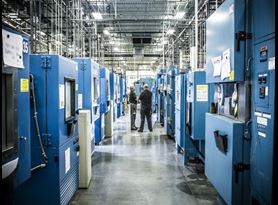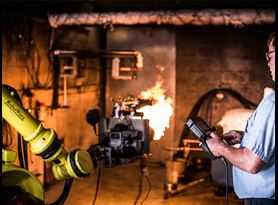ASTM D2863-17a Measuring Oxygen Index Testing on materials
ASTM D2863-17a establishes the minimum oxygen concentration that is required to support candle-like combustion in materials.
Oxygen concentration values are known as the Oxygen Index (OI) or, historically, the Limiting Oxygen Index (LOI). The oxygen concentration is measured using a paramagnetic oxygen analyzer and is controlled by varying the relative flow of oxygen and nitrogen through a vertical glass column. Specimens are supported vertically inside the glass column, and an ignition source is then placed in contact with the top edge of the specimen and withdrawn.
If “ignition” occurs, as defined differently by the standard for varying types of materials, then the oxygen concentration in the column is reduced for the next specimen. If ignition is unsuccessful, the oxygen concentration is increased for the next specimen. This systematic approach continues until the lowest oxygen concentration is determined that will support the combustion of the material.
The lower the Limiting Oxygen Index, the greater the propensity of that material to ignite and burn. For example, materials with established Oxygen Indices lower than 20.9% will continue to burn in normal atmospheric air, after an ignition source has been removed.
The Element Advantage
Depending on the type of material, Element’s team of experts select one of three testing methods. Procedure A measures top surface ignition. Procedure B measures propagating ignition, and Procedure C compares the material under test to a pre-established oxygen concentration to see whether or not combustion occurs. In such cases, a binary answer, which covers whether the ignition occurred or did not occur at O2 concentration X, is reported.
Materials are classified into six Types (Type I, II, III, IV, V, or VI). Types I to IV are self-supporting while Type V and VI require some form of physical support.
For more information on ASTM D2863-17a, contact us today.
Building Product Testing Services
Find related Resources
Learn more

Radiant Panel Test
Learn about Element's radiant panel test, the determination of the relative critical radiant flux, and the common standard methods of test ASTM E648 and NFPA 253.

Carbon Arc Testing
Element provides carbon arc testing on plastics, paints and coatings as well as other accelerated weathering testing methods to qualify new materials and determine their durability.

Steiner Tunnel Testing
Learn about reaction-to-fire testing on interior finish materials. A white paper on the differences between ASTM E84 and CAN/ULC-S102 Steiner Tunnel tests.

Fire and Flammability Testing
Learn about Element's complete range of flammability testing methods for aerospace and transportation, textiles, consumer goods, and furniture materials.

